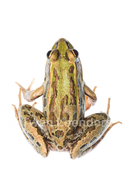|
Rana taylori Smith, 1959
Peralta frog Subgenus: Pantherana | family: Ranidae genus: Rana |
|
Taxonomic Notes: This species was placed in the genus Lithobates by Frost et al. (2006). However, Yuan et al. (2016, Systematic Biology, doi: 10.1093/sysbio/syw055) showed that this action created problems of paraphyly in other genera. Yuan et al. (2016) recognized subgenera within Rana for the major traditional species groups, with Lithobates used as the subgenus for the Rana palmipes group. AmphibiaWeb recommends the optional use of these subgenera to refer to these major species groups, with names written as Rana (Aquarana) catesbeiana, for example. |
|
 © 2017 Twan Leenders (1 of 6) |
|
|
|
Description Diagnosis: Rana taylori can be distinguished from other Costa Rican frogs by the following combination of characters: large body size (61-88 mm SVL), relatively short legs, distinct but discontinuous dorsolateral folds with the posterior part of the folds offset medially; large dorsal spots that are outlined in a lighter color and are often elongated in shape; webbed feet (Savage 2002). Description: Rana taylori adult males range from 61-78 mm in standard length and females range from 71 to 88 mm in standard length. R. taylori is a large, fairly short-legged brownish to gray-green frog. It has distinct but discontinuous dorsolateral folds with the posterior portion offset medially. The skin of the dorsal surfaces is generally smooth, except for the smooth dorsolateral folds and sometimes smooth tubercles and short ridges between the dorsolateral folds. The venter is smooth. The head is longer than wide, with a pointed snout in dorsal view. The tympanum is large, with its diameter roughly equal to the diameter of the eye. Finger I is longer than Finger II. Fingers are obtusely pointed, with round subarticular tubercles. Hands have no supernumerary, accessory palmar, or plantar tubercles. No lateral ridge on fingers. Thenar tubercle elongate, palmar tubercle irregular, tending to bifid or trifid. Tips of toes obtusely pointed, not expanded. Toes extensively webbed. Webs are deeply incised between toes II-III-IV. Inner metatarsal tubercle is elongated and there is no outer metatarsal tubercle. Males have a brownish nuptial pad on outer surface of thumb base, and the forearm is hypertrophied in larger adult males. Males also have paired light-colored lateral vocal pouches, and paired round vocal slits. The vocal sacs are concealed when deflated, in a slit under the tympanum at the edge of the lower jaw (Savage 2002). Coloration in life: Dorsum and upper surface of limbs are gray-tan or brownish to gray-green with large, frequently elongated dark spots outlined in a lighter shade. No dark eye mask is present. Supralabial light stripe is incomplete. Posterior thigh surface is mottled with dark and light. Undersurface is white. The iris is gold above and brown below (Savage 2002). Similar species: Rana taylori can be distinguished from R. forreri by having broken dorsolateral folds (vs. continuous in R. forreri), and from species of Leptodactylus by having webbed toes (vs. webbing not present in Leptodactylus) (Savage 2002). Distribution and Habitat Country distribution from AmphibiaWeb's database: Costa Rica, Nicaragua
Life History, Abundance, Activity, and Special Behaviors Like other amphibians, R. taylori can harbor parasites: one study found digeneans (Gorgoderina megacetabularis, G. parvicava, and Haematoloechus meridionalis) and nematodes (Oswaldocruzia costaricensis, Subulascaris falcaustriformis, and Porrocaecum sp.) (Goldberg and Bursey 2007). Larva Trends and Threats Rana taylori is part of a species complex (the Rana pipiens complex) which makes it difficult to obtain accurate population data (Bolaños et al. 2008). Possible reasons for amphibian decline General habitat alteration and loss
References
Bolaños, F., Chaves, G., Savage, J., and Köhler, G. 2008. Lithobates taylori. In: IUCN 2010. IUCN Red List of Threatened Species. Version 2010.4. Goldberg, S. R., and Bursey, C. R. (2007). ''Helminths of two species of frogs, Lithobates taylori and Lithobates vaillanti (Ranidae), from Costa Rica.'' Caribbean Journal of Science, 43, 65-72.
Savage, J. M. (2002). The Amphibians and Reptiles of Costa Rica:a herpetofauna between two continents, between two seas. University of Chicago Press, Chicago, Illinois, USA and London.
Smith, H. M. (1959). ''Herpetozoa from Guatemala. 1.'' Herpetologica, 15, 210-216.
Species Account Citation: AmphibiaWeb 2023 Rana taylori: Peralta frog <https://amphibiaweb.org/species/5166> University of California, Berkeley, CA, USA. Accessed Feb 4, 2025.
Citation: AmphibiaWeb. 2025. <https://amphibiaweb.org> University of California, Berkeley, CA, USA. Accessed 4 Feb 2025.
AmphibiaWeb's policy on data use.
|



 Map of Life
Map of Life